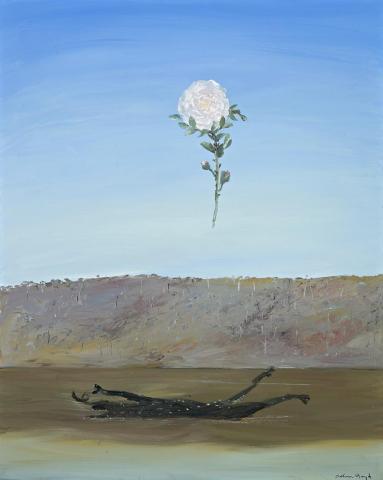RIVER IN FLOOD WITH CARCASS AND ROSE, 1974-75
ARTHUR BOYD
oil on canvas
152.5 x 121.0 cm
signed lower right: Arthur Boyd
Private collection, Sydney
McGrath, S., The Artist and the River: Arthur Boyd and the Shoalhaven, Bay Books, Sydney, 1982, pp. 262, 263 (illus.)
Arthur Boyd first visited the Shoalhaven in 1972, returning from his home in England to undertake a six month arts fellowship at the Australian National University in Canberra, when invited by his friend, the Sydney art dealer Frank McDonald, to spend the weekend at his Georgian stone house, Bundanon. Instantly the Boyds fell in love with the area, as indeed had an impressive lineage of Australian painters before, such as Conrad Martens, Elioth Gruner and Roy de Maistre, (and after) Brett Whiteley, John Olsen and Tim Storrier.
But for Boyd, the attraction to this land was consuming: as was his affection for Bundanon. Before leaving Australia he asked McDonald to look for a property he could purchase nearby and within months of returning to England the Boyds had acquired, sight unseen, a 100 acre property about six kilometres east of Bundanon, called Riversdale.
Boyd's contact with the Shoalhaven caused a surge of creative activity which continued upon his return to England, with a number of images of the Shoalhaven exhibited at Fischer Fine Art, London in 1973. These were to be the first of a body of work Boyd was to revisit and renew for the rest of his life, so captured was he by the harsh, raw beauty of the area. 'The Shoalhaven is the only untamed landscape I have ever seen.'1
In 1976, the house was rebuilt at Riversdale and the Boyds moved in after staying six months at a nearby property while the building was completed. It was during this time that Arthur Boyd experienced firsthand the unpredictable power of the river with a major flood hampering the completion of the building and isolating him in their temporary home.
We were marooned in a way that was an initiation. As the days wore on it became more and more intense, and the feeling that you could never get away from it. Since then I have been marooned at Riversdale several times. The river moans and groans in a muted way, and great chunks of what was upstream comes down - dead cattle with their legs sticking up, logs and roof tops. Once a whole house came down the river.2
As Sandra McGrath writes, 'He sees the rose as being a symbol of the attempt of Europeans, and in particular the English (as in a rose-covered cottage) to impose on the land of the Aboriginal an alien culture and civilisation. He finds the attempt futile, as the rose cannot flourish in a ground more suited to spinifex. Boyd's rose floats in full bloom like a cloud above the stark and vast reaches of the Shoalhaven hills and streams. ... But the rose as a symbol is charged with other meanings than the one Boyd gives to it, as he undoubtedly knows. It is the flower of Venus, a symbol of joy, victory or perfection. The single rose, like a mandala, stands for the mystic centre ...'3
Writing directly about the work on offer, River in Flood with Carcass and Rose, Arthur Boyd states,
I had been in England during the Great Flood of 1974. When I was visiting Bundanon some time later I heard a story of the devastation that the river had caused. It ravaged the landscape and the stock. The enormous Santa Gertrudis had been a victim.
The rose symbolises the imposition and the cultural arrogance of the English as they tried to make 'a little England' in Australia. I was also trying to show the fragility of transporting this culture into such a harsh environment. The rose and the carcass are contrasting symbols.4
1. McGrath, S. The Artist and The River: Arthur Boyd and The Shoalhaven, Bay Books, Sydney, 1982, p. 51
2. Ibid., p. 58
3. Ibid., p. 66
4. Ibid., p. 262
